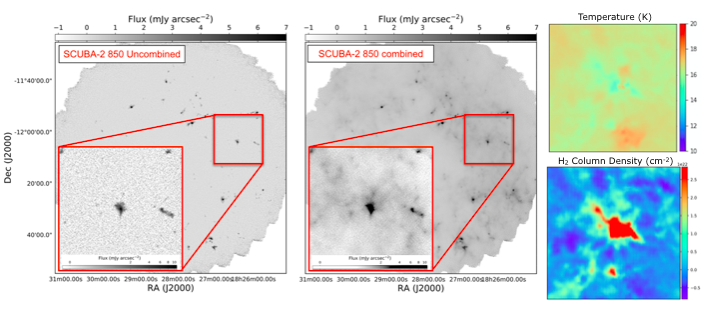A Lei of the Habitat and Assembly of Infrared Dark Clouds
The JCMT legacy survey, A Lei of the Habitat and Assembly of Infrared Dark Clouds (ALOHA), focuses on the initial conditions of the Galactic massive star formation. This program aims for the highest extended-source sensitivity (2mJy/beam, on par with the confusion limit) possible with SCUBA-2 to systematically map out the habitat and assembly of the IRDCs. Through our own newly developed multi-band analysis tool, namely J-COMB, this survey will provide unprecedented spatial resolution and intensity dynamical range, crucial for revealing full IRDC structures (filaments, envelopes, as well as dense cores), discerning evolutionary states, recovering the true N-PDF, and constraining dust properties in massive star forming regions. Each IRDC in this sample can be resolved down to the thermal Jeans scale. The ALOHA dataset will establish a framework for future studies with its depth and high sensitivity to understand massive star formation.

The comparison of uncombined and combined JCMT 850μm images of one IRDC (SDC19.376-0.034) obtained through JPS. The significant extended structures missed out from SCUBA-2 image from JPS alone can be recovered properly with our own innovative J-COMB multi-band analysis tool with sufficient intensity dynamic range while preserving spatial resolution, both of which are crucial for studying gas assembly.
The ALOHA sample is selected from the largest IRDC catalogue completed by our team (Peretto & Fuller 2009), which consists of the most quiescent IRDCs based on Spitzer 8μm absorption and Herschel bands. We select all regions in this catalogue within 1.5 kpc and structures resolvable by JCMT. The targeted rms (2mJy/beam) at 850μm continuum sensitivity is 5 to 10 times deeper than any previous JCMT Galactic survey including JPS (Eden et al. 2016), TOP-SCOPE (Liu et al. 2019), etc. Thus, the proposed observation represents the most sensitive imaging survey of a complete, distance-limited, spatially resolved, quiescent IRDC sample, which is especially suitable for studying the initial conditions of massive star formation with JCMT.
To maximize the science output from ALOHA and to overcome missing flux and structures due to atmospheric instabilities, SCUBA-2 images will be combined and analyzed together with Spitzer absorption, Herschel, and Planck absorption through our own multi-band dust imaging combination and analysis tool J-COMB (Lin et al. 2017; Jiao et al. 2019). The combined images will have the necessary dynamic range, roughly 4.3×1020-24 cm-2, which is critical for recovering both dense core peaks, extended structures (filaments), and their environments. A credible and comprehensive column-density probability functions (N-PDF) analysis is not possible with shallower surveys but will be with ALOHA. ALOHA will shed significant lights into dense gas assemble, filament formation, fragmentation, dust properties, energy balance, and the general evolutionary trend of IRDCs, which are promising sites for massive star formation.
Regional Coordinators: Di Li (NAOC), Xie Jinjin (SHAO), Gary Fuller (University of Manchester), Ken’ichi Tatematsu (NAOJ), Hauyu Baobab Liu (ASIAA), Kee-Tae Kim (KASI), Pham Ngoc Diep (Vietnam National Space Centre), Busaba Kramer (NARIT), Zhiyuan Ren (NAOC), Junhao Liu (EAO).
– JCMT program code M20AL021



